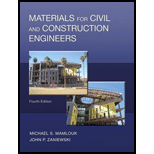
The shape and surface texture of aggregate particles are important for both portland cement concrete and asphalt concrete.
a. For preparing PCC, would you prefer round and smooth aggregate or rough and angular aggregate? Briefly explain why (no more than two lines).
b. For preparing HMA, would you prefer round and smooth aggregate or rough and angular aggregate? Briefly explain why (no more than two lines).
Want to see the full answer?
Check out a sample textbook solution
Chapter 5 Solutions
Pearson eText for Materials for Civil and Construction Engineers -- Instant Access (Pearson+)
Additional Engineering Textbook Solutions
INTERNATIONAL EDITION---Engineering Mechanics: Statics, 14th edition (SI unit)
Starting Out With Visual Basic (8th Edition)
Starting Out with Programming Logic and Design (5th Edition) (What's New in Computer Science)
Elementary Surveying: An Introduction To Geomatics (15th Edition)
Fluid Mechanics: Fundamentals and Applications
Thinking Like an Engineer: An Active Learning Approach (4th Edition)
- The mass of fine aggregate B has been reduced and weighed to conduct an aggregate test shown in Table 2. (e) Calculate the dry bulk specific gravity, SSD bulk specific gravity, apparent specific gravity, and the aggregate absorption.arrow_forwardConcretearrow_forwardSamples of coarse aggregate from a stockpile are brought to the laboratory for determination of specific gravities. The following weights are found: Mass of moist aggregate sample as brought to the laboratory: 5,298 grams Mass of oven dried aggregate: 5,216 g Mass of aggregates submerged in water: 3,295 g Mass of SSD (Saturated Surface Dry) Aggregate: 5,227 g Find a. The aggregate bulk dry specific gravity b. The aggregate apparent specific gravity c. The moisture content of stockpile aggregate (report as a percent) d. Absorption (report as percent)arrow_forward
- In designing a concrete mix, if the amount of mixing water is estimated at W = 185 Kg/m, the SSD weight of the coarse aggregate is 1045 Kg/m, and the SSD weight of the fine aggregate is 617 Kg/m. The coarse aggregate has a moisture content of 1% and an absorption capacity of 2%. The fine aggregate has a moisture content of 2% and an absorption capacity of 5%. The adjusted weight of mixing water (in Kg/m³) is: O 177 O 214 156 193 O 172 O O O O Oarrow_forwardplease quickly thanks !arrow_forwardAggregates from three sources having the properties shown in the table below where blended at a ratio of 30:45:25 by weight. Determine the properties of the aggregate blend. (Please show me in direct solution)arrow_forward
- The mass of aggregate B has been reduced and weighed to conduct an aggregate test shown in Table 2. (a) Calculate the: (i) dry bulk specific gravity (ii) SSD bulk specific gravity,arrow_forwardPlease in 15 minarrow_forwardExample 2: Design a concrete mix to implement a concrete slab (exposed to sever conditions moisture and freezing and thawing) with design compressive strength 30 MPa, a standard deviation equals to 4 and the percentage expected less than minimum strength is 10%. Sulphate Resisting Portland Cement is used. The maximum size of an angular aggregate is 20 mm with apparent density 1500 kg/m3. The available fine aggregate has fineness modulus 2.4 An air entraining agent has been used in the mix.arrow_forward
- There are two sources of aggregates (A, B). A sample has been taken from both sources and measured their mass as shown in table below. Measurement Wet mass (9) Oven-dry mass (g) Aggregate A 500 480 Aggregate B 600 564 (a) Determine the total moisture content for the samples from both aggregate sources, respectively. (b) Determine the total moisture content for an aggregate blend with 30% of aggregate A and 70% of aggregate B.arrow_forwardPleasearrow_forwardi need the answer quicklyarrow_forward

 Structural Analysis (10th Edition)Civil EngineeringISBN:9780134610672Author:Russell C. HibbelerPublisher:PEARSON
Structural Analysis (10th Edition)Civil EngineeringISBN:9780134610672Author:Russell C. HibbelerPublisher:PEARSON Principles of Foundation Engineering (MindTap Cou...Civil EngineeringISBN:9781337705028Author:Braja M. Das, Nagaratnam SivakuganPublisher:Cengage Learning
Principles of Foundation Engineering (MindTap Cou...Civil EngineeringISBN:9781337705028Author:Braja M. Das, Nagaratnam SivakuganPublisher:Cengage Learning Fundamentals of Structural AnalysisCivil EngineeringISBN:9780073398006Author:Kenneth M. Leet Emeritus, Chia-Ming Uang, Joel LanningPublisher:McGraw-Hill Education
Fundamentals of Structural AnalysisCivil EngineeringISBN:9780073398006Author:Kenneth M. Leet Emeritus, Chia-Ming Uang, Joel LanningPublisher:McGraw-Hill Education
 Traffic and Highway EngineeringCivil EngineeringISBN:9781305156241Author:Garber, Nicholas J.Publisher:Cengage Learning
Traffic and Highway EngineeringCivil EngineeringISBN:9781305156241Author:Garber, Nicholas J.Publisher:Cengage Learning





